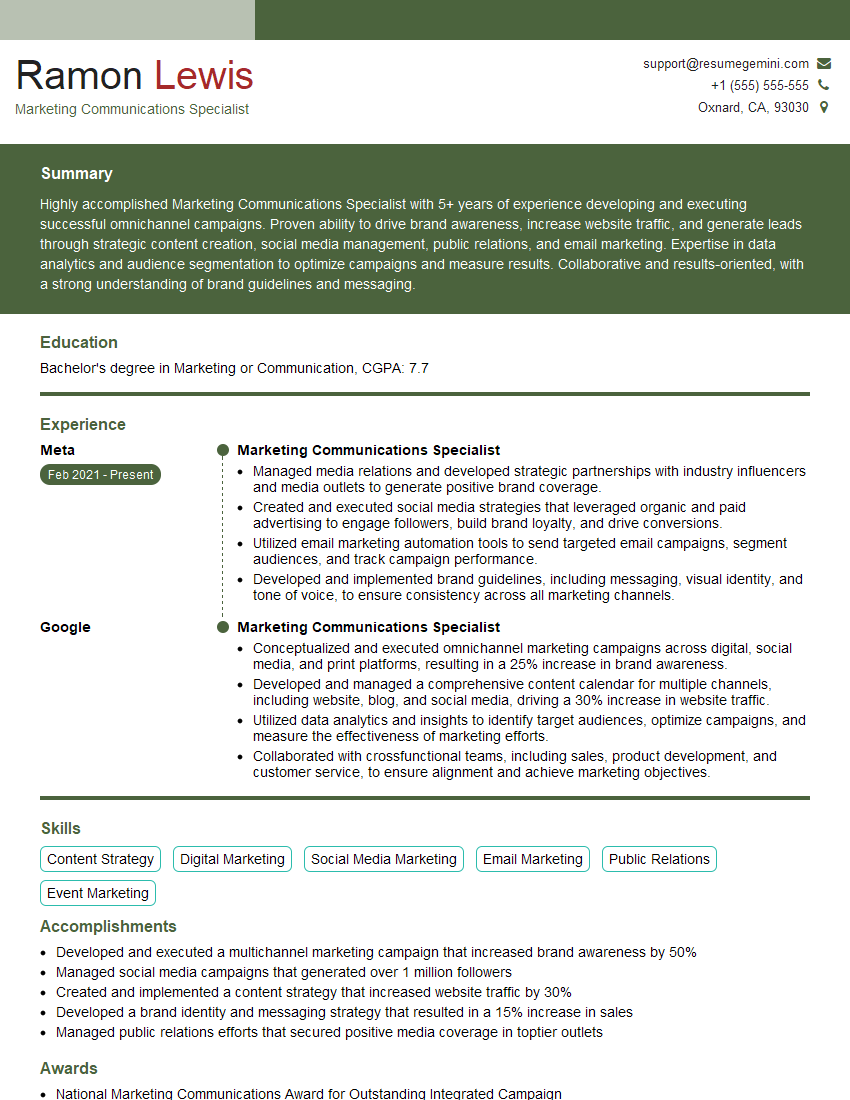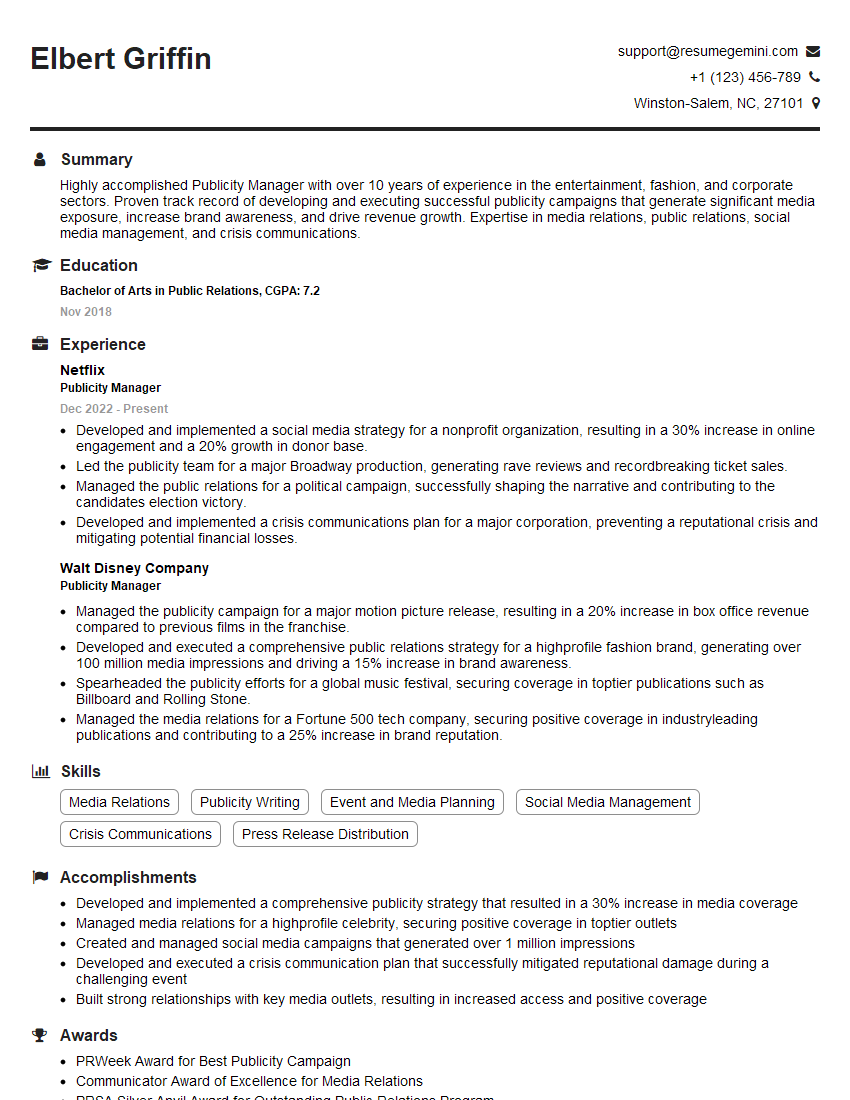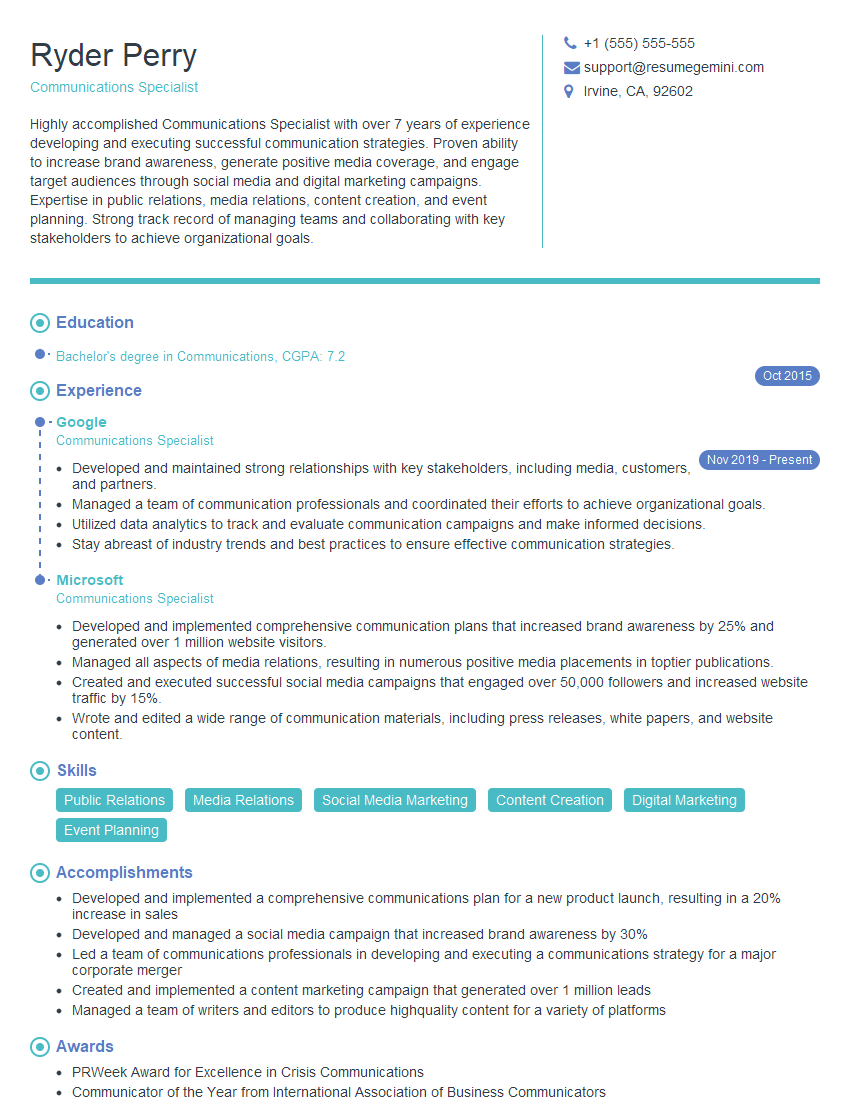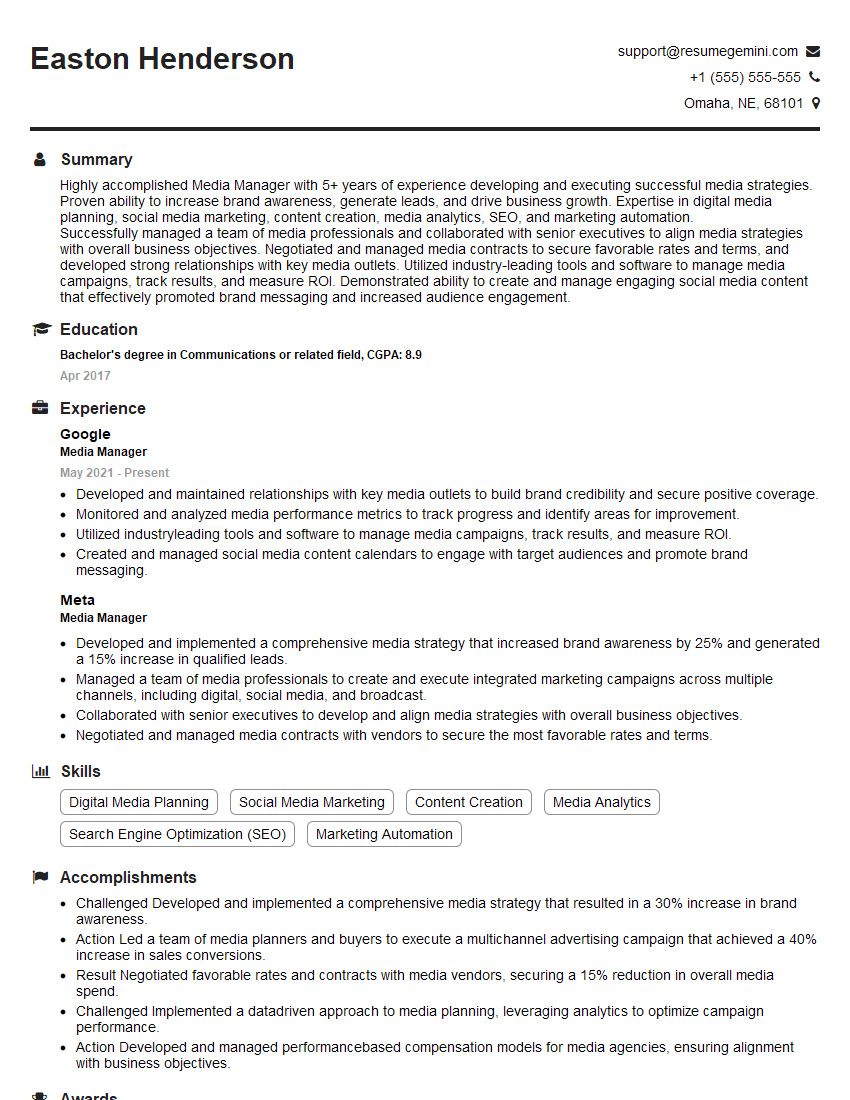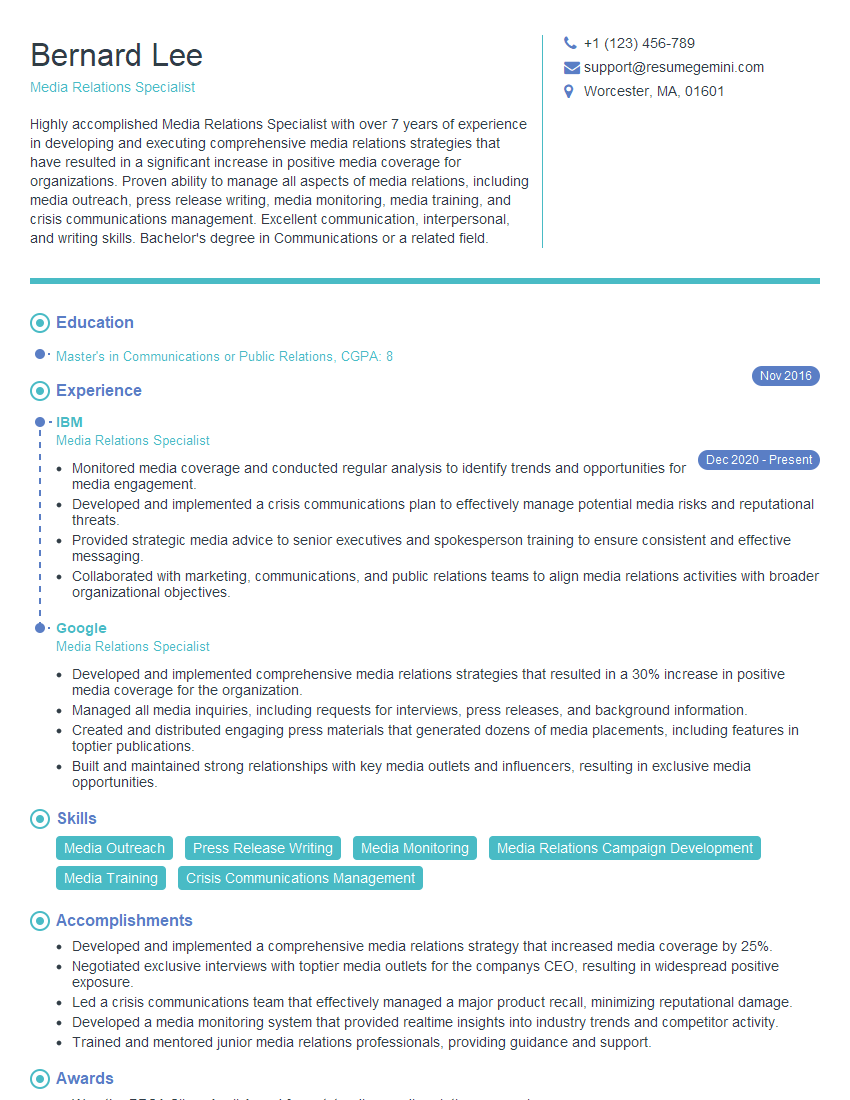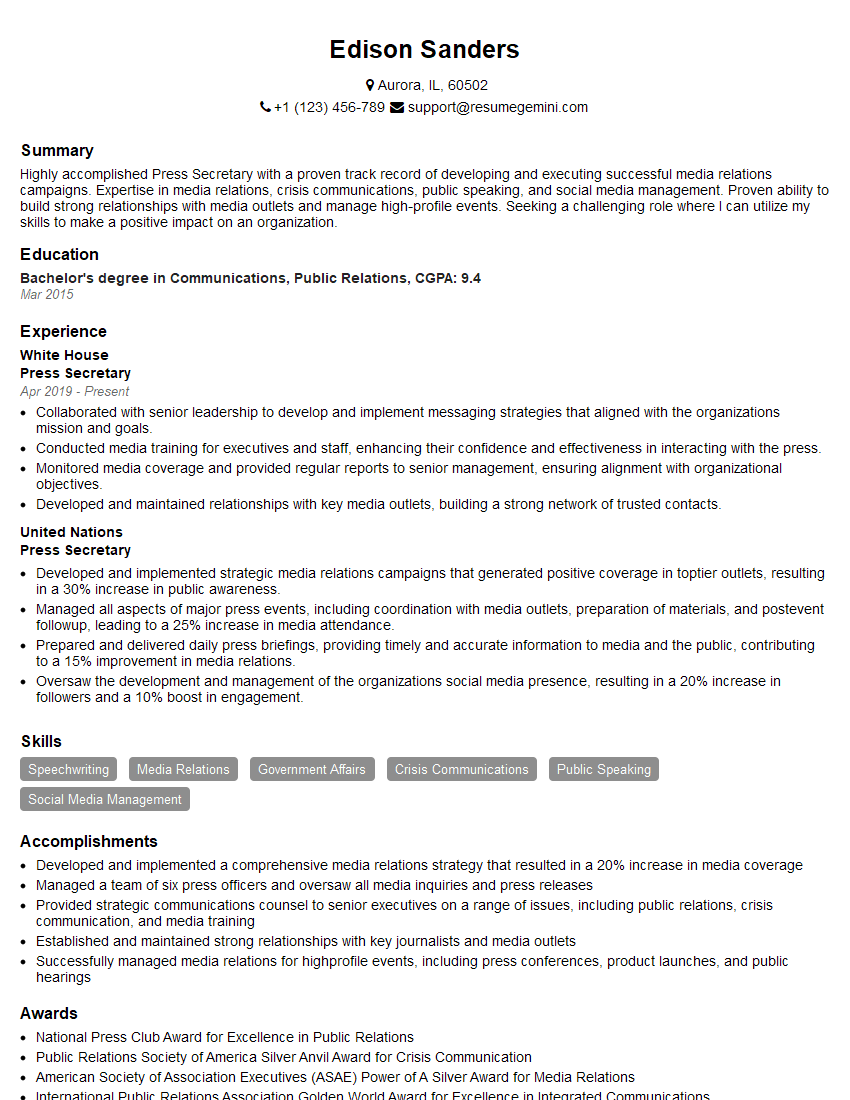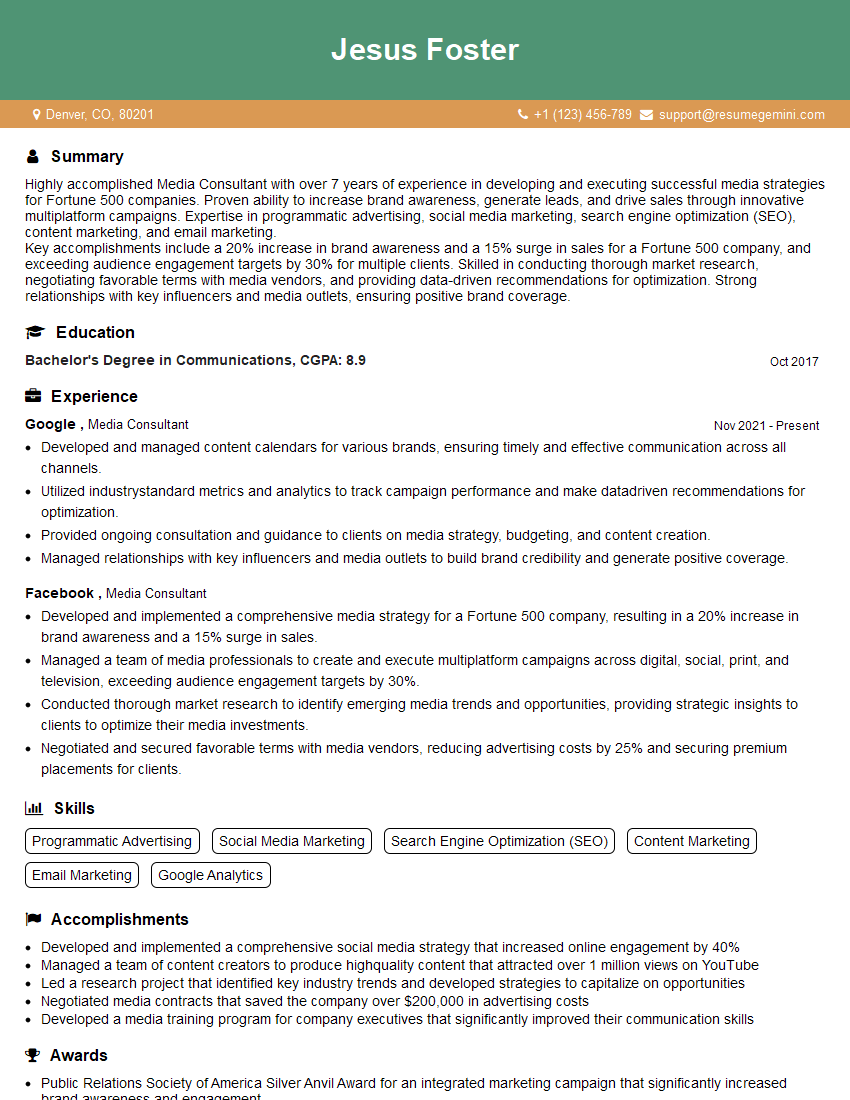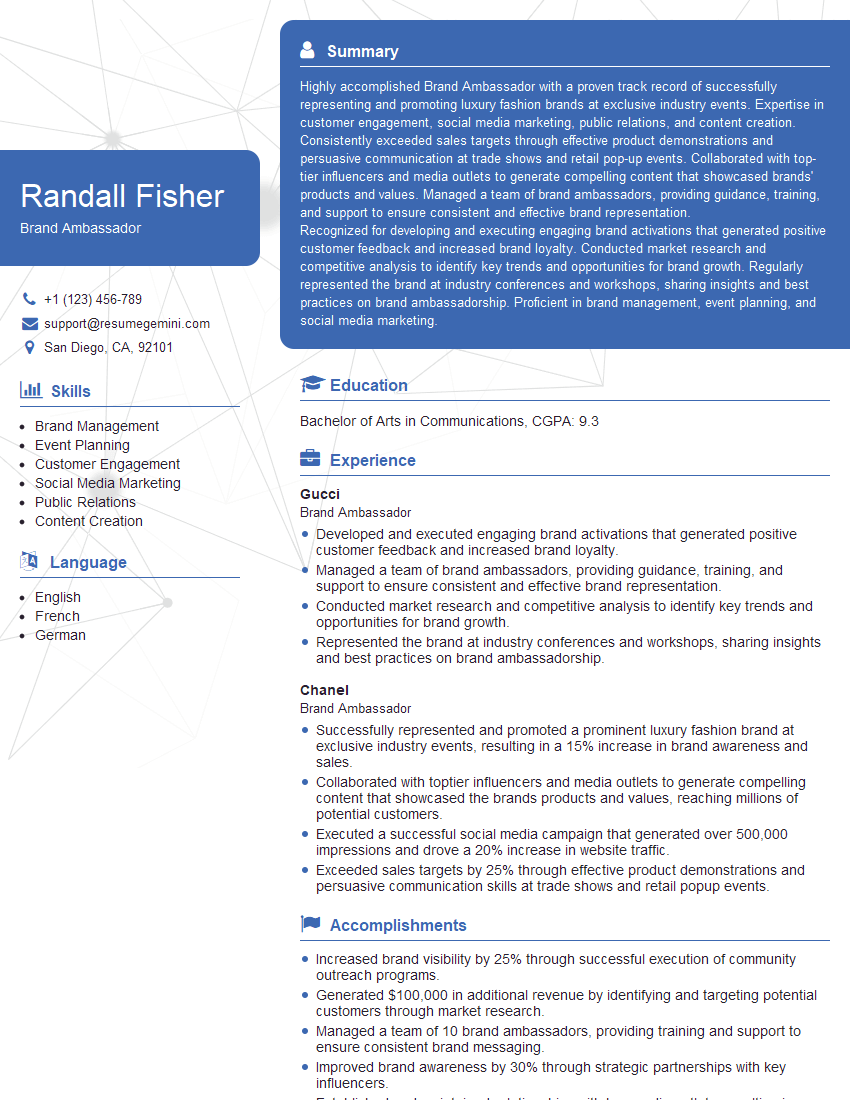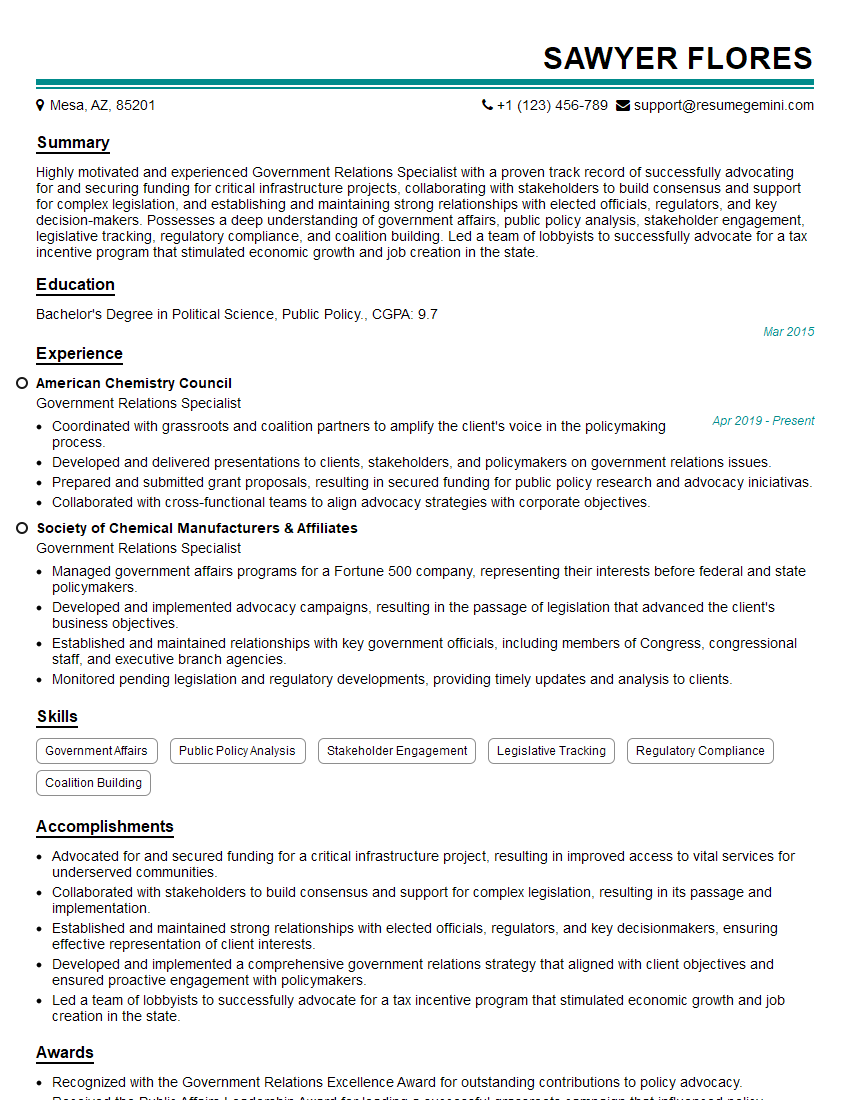Cracking a skill-specific interview, like one for Ability to interact with the media and press, requires understanding the nuances of the role. In this blog, we present the questions you’re most likely to encounter, along with insights into how to answer them effectively. Let’s ensure you’re ready to make a strong impression.
Questions Asked in Ability to interact with the media and press Interview
Q 1. Describe your experience handling media inquiries during a crisis.
Handling media inquiries during a crisis requires a swift, coordinated, and transparent approach. My experience involves establishing a dedicated crisis communication team, immediately assessing the situation’s impact and potential consequences, and developing key messages to proactively address concerns. We prioritize accurate and consistent information dissemination across all channels.
For example, during a product recall, we established a 24/7 hotline, issued regular press releases with factual updates, and proactively engaged with key journalists to ensure consistent messaging. We also identified and addressed misinformation swiftly and transparently. This proactive approach helped mitigate negative publicity and maintain public trust.
Q 2. How do you craft compelling press releases?
Crafting compelling press releases involves understanding your target audience and the core message you wish to convey. The structure should be clear, concise, and engaging, grabbing attention from the headline onwards. Think of the inverted pyramid style: start with the most important information, then provide details, and end with less critical information.
- Headline: Must be catchy and accurately reflect the content.
- Lead Paragraph: Summarize the key information – who, what, when, where, why.
- Body: Expand on the details, providing supporting evidence and quotes.
- Boilerplate: Briefly describe your organization.
- Contact Information: Provide details for media inquiries.
For instance, a press release announcing a new product would start with the product name and key features in the headline and lead, followed by detailed specifications, benefits, and customer testimonials in the body.
Q 3. What strategies do you employ to build and maintain positive media relationships?
Building and maintaining positive media relationships is crucial for long-term success. It’s about developing genuine connections based on trust and mutual respect. This involves regular communication, even outside of news cycles.
- Proactive Engagement: Share news and updates, even if they aren’t breaking news.
- Personalized Communication: Address journalists by name, and tailor your communications to their interests.
- Responsiveness: Respond to media inquiries promptly and professionally.
- Transparency: Be honest and upfront, even when delivering difficult news.
- Relationship Building: Attend industry events and cultivate relationships with journalists covering your industry.
For example, I regularly send journalists relevant industry articles, invite them to exclusive events, and offer them behind-the-scenes access to our work. This proactive engagement fosters trust and mutual respect.
Q 4. Explain your process for developing a media strategy.
Developing a media strategy involves a multi-step process starting with defining your objectives. What do you want to achieve through media engagement? Next, we identify your target audience and key messages.
- Define Objectives: What are your goals? Increase brand awareness? Launch a new product?
- Identify Target Audience: Which media outlets reach your target audience?
- Develop Key Messages: What are the core messages you want to communicate?
- Select Media Channels: Which channels will be most effective? (Press releases, social media, interviews, etc.)
- Create a Content Calendar: Plan your media outreach activities.
- Monitor and Evaluate: Track your results and adjust your strategy as needed.
For example, if launching a new sustainable product, we’d target environmental publications and news outlets, emphasizing the product’s eco-friendly features in all communications.
Q 5. How do you manage competing media demands?
Managing competing media demands requires careful prioritization and efficient time management. This involves assessing the urgency and importance of each request.
- Prioritization Matrix: Use a matrix to prioritize requests based on urgency and importance.
- Time Blocking: Allocate specific times for responding to media inquiries.
- Delegation: Delegate tasks where possible.
- Clear Communication: Set clear expectations with journalists regarding timelines.
I use a project management tool to track all media inquiries, deadlines, and assigned tasks, ensuring that no request is overlooked and resources are allocated effectively.
Q 6. How do you prepare for a live television interview?
Preparing for a live television interview involves thorough research and practice. This includes understanding the show’s format, the interviewer, and the likely questions.
- Research: Research the show, the interviewer, and past interviews.
- Practice: Rehearse your responses to potential questions. Consider mock interviews.
- Key Messages: Identify three to five key messages you want to convey.
- Visual Aids: Prepare any visual aids you may need.
- Attire: Dress professionally and appropriately for the occasion.
I always prepare a concise, one-page briefing document outlining my key messages and potential responses to anticipated questions. This ensures I remain focused and deliver a confident and clear message.
Q 7. How do you handle difficult or adversarial questions from the media?
Handling difficult or adversarial questions requires calm, composed responses. Listen carefully to the question, take a moment to collect your thoughts before answering, and avoid getting defensive.
- Listen Carefully: Understand the question fully before responding.
- Answer Directly: Address the core of the question without getting sidetracked.
- Bridge to Key Messages: Transition smoothly to your key messages.
- Don’t Speculate: Stick to the facts and avoid making assumptions.
- Remain Calm and Professional: Even if the question is provocative, maintain your composure.
For example, if faced with an accusatory question, I would acknowledge the concern, restate the facts accurately, and then reiterate our commitment to transparency and ethical conduct. This helps to de-escalate the situation and redirect the conversation to more positive aspects.
Q 8. What metrics do you use to measure the success of a media campaign?
Measuring the success of a media campaign isn’t solely about vanity metrics like impressions or reach. It requires a multifaceted approach, focusing on quantifiable results aligned with campaign objectives. We utilize a blend of quantitative and qualitative metrics.
- Quantitative Metrics: These are easily measurable numbers. Examples include website traffic from media mentions (using UTM parameters), social media engagement (likes, shares, comments), lead generation from media coverage, sales uplift attributable to the campaign, and changes in brand awareness scores from surveys or sentiment analysis. We’ll track increases in website traffic to specific landing pages after a media hit, or track the percentage increase in sales after a successful product launch feature.
- Qualitative Metrics: These delve deeper into the impact. We analyze media mentions for tone (positive, negative, neutral), the reach and influence of the publications involved, and the overall narrative shaping public perception. We also analyze audience feedback through social listening and surveys, looking for changes in brand sentiment or knowledge.
For instance, a successful campaign might show a significant increase in website traffic from specific media outlets alongside a positive shift in public perception of our brand, as shown by an improved sentiment score in social media monitoring reports.
Q 9. Describe your experience working with different media outlets (print, broadcast, online).
My experience spans a wide range of media outlets. In print, I’ve worked extensively with major newspapers and industry-specific magazines, focusing on crafting compelling press releases and pitching stories that resonate with their target audiences. For broadcast media, I’ve coordinated interviews on television and radio, preparing spokespeople and ensuring concise, impactful messaging. My online experience includes managing social media campaigns, engaging with online journalists and influencers, and leveraging digital PR strategies to maximize online visibility and reach. I’ve successfully coordinated with outlets ranging from local news channels to national publications, tailoring communications to suit each medium’s style and audience.
For example, a recent product launch involved a detailed press kit for print media, a concise, engaging video for online and broadcast, and an interactive social media campaign using short videos and behind-the-scenes content. Each medium received tailored content to maximize its impact.
Q 10. How do you ensure consistent messaging across various media channels?
Maintaining consistent messaging across various media channels is critical for building a cohesive brand image and avoiding conflicting narratives. This involves creating a central messaging document that outlines key points, target audiences, and desired outcomes. This document serves as a guide for all communications, ensuring that every press release, interview, social media post, and online article reflects the same core message. We use a key message framework that is concise, easily digestible and adaptable to different media formats.
For example, if we are launching a new product with three key benefits, we make sure every communication highlights these three benefits, although the order and emphasis might vary depending on the platform and the target audience. We also rigorously review all materials before release to ensure consistency.
Q 11. How do you identify key media targets for your organization?
Identifying key media targets is a strategic process. We begin by defining our target audience and then identifying media outlets that reach those audiences. This involves a detailed analysis of media landscapes, considering readership, viewership, and influence. We look at factors such as audience demographics, editorial focus, and past coverage of similar topics. We often use media databases and monitoring tools to assist this.
For instance, if we are targeting a younger demographic interested in sustainable practices, we’d prioritize online publications and influencers with a strong environmental focus, rather than focusing on print publications with an older readership. Building relationships with key journalists is also crucial for long-term success.
Q 12. Explain your process for responding to negative media coverage.
Responding to negative media coverage requires a swift, transparent, and empathetic approach. We first acknowledge the concerns raised, taking responsibility where appropriate and providing accurate information to correct any misinformation. Our process involves a rapid assessment of the situation, formulation of a clear and concise response, and coordination with relevant internal stakeholders. This often involves preparing a statement and engaging with the journalist or publication directly. We prioritize honesty, and addressing concerns head-on.
We carefully analyze the context of the negative coverage to identify the root cause. If it’s a factual error, we provide correction. If it’s a valid criticism, we address it openly and work towards solutions. We learn from each experience to improve our processes and mitigate future risks.
Q 13. How do you build trust and credibility with the media?
Building trust and credibility with the media is an ongoing process built on transparency, responsiveness, and consistent reliability. We prioritize open communication, promptly responding to inquiries and providing journalists with accurate information. We also foster relationships by building personal connections with reporters and editors, understanding their beats and demonstrating respect for their time and professionalism. We are proactive in sharing information and always aim for truth and accuracy.
For example, proactively offering exclusive interviews or providing background information builds strong relationships. Being honest and transparent in both positive and negative situations strengthens trust over time.
Q 14. What is your approach to media monitoring and analysis?
Media monitoring and analysis are essential for understanding our brand’s public perception and the effectiveness of our communications. We utilize media monitoring tools to track mentions across various platforms—print, broadcast, online, and social media. This includes not just identifying mentions but also analyzing the sentiment (positive, negative, neutral), reach, and key themes emerging in the coverage. We use this data to understand our brand’s image, track media trends, and inform future communications strategies. Regular reports are prepared summarizing findings and informing strategic decision-making.
For example, a sudden spike in negative mentions related to a specific product feature might indicate a need for immediate clarification or a product adjustment. This data-driven approach allows us to adapt and improve our communications continuously.
Q 15. How do you handle requests for information outside of your area of expertise?
When a media inquiry falls outside my expertise, honesty and efficiency are paramount. I never pretend to know something I don’t. Instead, I acknowledge the limitation immediately and offer a solution. This typically involves two steps: First, I politely inform the journalist that I don’t have the specific expertise they’re looking for, expressing appreciation for their inquiry. Second, I offer to connect them with the appropriate person or department within our organization who *does* possess that knowledge. For example, if a journalist asks about our company’s manufacturing processes and that’s not my area, I’d direct them to our VP of Operations. This approach maintains transparency, protects the company’s reputation, and fosters positive relationships with the media.
Alternatively, if an internal expert isn’t readily available, I might suggest other resources such as published reports or industry articles that address their question. The key is to be responsive and helpful, even if it means directing the inquiry elsewhere. This proactive approach helps build trust and keeps the journalist from pursuing less accurate information elsewhere.
Career Expert Tips:
- Ace those interviews! Prepare effectively by reviewing the Top 50 Most Common Interview Questions on ResumeGemini.
- Navigate your job search with confidence! Explore a wide range of Career Tips on ResumeGemini. Learn about common challenges and recommendations to overcome them.
- Craft the perfect resume! Master the Art of Resume Writing with ResumeGemini’s guide. Showcase your unique qualifications and achievements effectively.
- Don’t miss out on holiday savings! Build your dream resume with ResumeGemini’s ATS optimized templates.
Q 16. Describe a time you had to adapt your media strategy due to unforeseen circumstances.
During a product launch, a major competitor unexpectedly released a similar product, creating a crisis. Our initial positive-news-focused media strategy needed immediate adjustment. We held an emergency meeting and pivoted. Instead of solely promoting the features, we highlighted our unique selling proposition (USP) – a patented technology the competitor lacked – emphasizing its superiority and addressing the comparison directly and proactively. We prepared a Q&A document addressing anticipated questions about the competing product. We also created short, impactful videos explaining the USP’s benefits and emphasizing our commitment to innovation. This transparent approach, coupled with preemptive communication, diffused much of the negativity and actually strengthened our brand image by demonstrating confidence and responsiveness.
Q 17. What is your experience with social media in relation to media relations?
Social media is integral to modern media relations. It’s not just about posting press releases; it’s about engaging in a two-way conversation. I use platforms like Twitter, LinkedIn, and even Instagram to build relationships with journalists, monitor news coverage, respond to mentions, and share relevant content. For instance, I actively follow relevant journalists on Twitter and engage with their tweets. This shows I’m attentive to their work and build rapport. Furthermore, social listening tools help track mentions of our company and our competitors. This lets us identify potential opportunities and address issues promptly.
I also leverage social media to amplify our press releases and other media coverage. Sharing articles on LinkedIn, for instance, increases their reach and enhances the visibility of our messaging. I’m careful to maintain a consistent brand voice and communicate thoughtfully, avoiding overly promotional language and instead focusing on providing value to our followers. Social media is a vital tool for reputation management, crisis communication, and relationship building with both the media and the public.
Q 18. How do you measure the ROI of your media efforts?
Measuring the ROI of media efforts requires a multifaceted approach. It’s not simply about counting press mentions. Instead, I utilize a combination of quantitative and qualitative metrics. Quantitatively, I track media mentions (including reach and impressions), website traffic from media coverage, social media engagement, and lead generation. Software tools help me monitor media coverage and track these metrics effectively.
Qualitatively, I assess the tone of the coverage (positive, negative, or neutral), the impact on brand perception (measured through surveys or social listening), and the overall contribution to business objectives (such as increased sales or brand awareness). For example, a positive feature article in a leading industry magazine might lead to a measurable increase in website traffic and sales inquiries. I then correlate this data with the investment made in our media relations efforts to calculate a more comprehensive ROI.
Q 19. How familiar are you with media law and regulations?
I have a strong understanding of media law and regulations, including libel, slander, privacy, copyright, and freedom of information laws. I understand the importance of fact-checking and accuracy in all communications and regularly review any materials I release or approve with a keen eye for potential legal risks. I know the nuances of different jurisdictions and adapt my approach accordingly. For example, the regulations governing media releases and press conferences differ between countries. This awareness is crucial for preventing costly legal battles and protecting the company’s reputation.
I consult with legal counsel when necessary, particularly on sensitive issues, and ensure that all materials released are compliant with relevant laws and regulations. This includes understanding and respecting confidentiality agreements, avoiding the release of sensitive company information, and protecting the privacy of employees and other individuals. Proactive legal awareness is integral to responsible and ethical media relations.
Q 20. What is your understanding of different media platforms and their target audiences?
I’m familiar with a wide range of media platforms, from traditional outlets like newspapers and television to digital platforms such as blogs, podcasts, and social media. Each has a distinct target audience and requires a tailored approach. For example, a technical journal article would be an effective medium to reach engineers and technology professionals, while a consumer magazine would be more suitable for the general public. Understanding the nuances of each platform—its audience, tone, and style—is essential for effective communication.
My strategy involves identifying the most appropriate platforms for our messages and tailoring the content to resonate with each audience. This understanding extends to the different formats as well. A concise press release suits news organizations, while an in-depth interview may be better for podcasts. Adaptability and awareness are key to optimizing our media outreach.
Q 21. Describe your experience with media pitching and outreach.
My experience with media pitching and outreach is extensive. I develop targeted pitch lists based on the story’s relevance to the publication’s audience and editorial focus. Before pitching, I thoroughly research the journalist and publication to ensure alignment. The pitch itself must be concise, compelling, and highlight the unique news value of the story.
I typically use a combination of email and phone calls for initial outreach. Following up is crucial; often, a few gentle reminders are necessary. Building relationships with journalists is a long-term investment; consistent engagement and providing valuable information foster trust and increase the likelihood of future coverage. I maintain a database of contacts, track communication, and analyze the effectiveness of different outreach strategies to constantly improve my approach.
Beyond traditional pitching, I sometimes proactively offer journalists exclusive interviews or access to relevant materials. This tailored approach significantly increases the probability of media coverage.
Q 22. What strategies do you use to effectively manage media expectations?
Managing media expectations effectively involves proactive communication and realistic goal-setting. It’s about setting clear, achievable expectations with journalists from the outset. This includes being transparent about what information can and cannot be shared, establishing clear deadlines for responses, and being upfront about any limitations or challenges.
For example, if a company is facing a crisis, setting expectations early about the timeline for releasing information can prevent misinformation from spreading. This might involve a statement saying, “We are currently investigating the situation and will issue a comprehensive update within 24 hours.” This manages expectations by providing a timeframe and preventing speculation. Another strategy is proactively briefing key journalists on upcoming announcements or events. This gives them a head start and often leads to more favorable coverage.
- Proactive Communication: Regular briefings and updates.
- Realistic Goal Setting: Avoiding overpromising and underdelivering.
- Transparency: Openly acknowledging limitations.
- Relationship Building: Cultivating strong relationships with media contacts.
Q 23. How do you ensure the accuracy of information provided to the media?
Accuracy is paramount in media relations. My approach involves a multi-layered process to ensure that the information disseminated is factual and verifiable. This starts with internal fact-checking, involving subject matter experts to review all information before it’s released. We meticulously cross-reference data and cite sources to avoid errors. Before releasing any information, we prepare a detailed press kit with all the necessary background information, data sheets, and supporting documents.
For instance, when dealing with complex financial data, I would involve our finance team to ensure the accuracy of figures and projections before sharing them with journalists. We also maintain a detailed internal database of past releases and communications to avoid inconsistencies or contradictions. If a mistake is discovered after a release, we issue a correction promptly and transparently, owning the error.
- Internal Fact-Checking: Multiple levels of review by experts.
- Source Verification: Citing credible and verifiable sources.
- Data Validation: Ensuring numerical accuracy.
- Prompt Corrections: Addressing errors transparently and quickly.
Q 24. Describe your experience using media databases and monitoring tools.
I’m proficient in utilizing various media databases and monitoring tools to track media coverage, identify key influencers, and analyze media trends. I regularly use tools like Cision, Meltwater, and Factiva. These platforms allow me to monitor mentions of our organization across various media outlets (print, online, broadcast) and analyze the sentiment expressed. This goes beyond simply searching for keywords; I use advanced search filters to narrow results by publication type, geographic location, and date range. I also use these tools to identify journalists specializing in relevant fields, building relationships and pitching stories strategically.
For example, if launching a new product in the tech sector, I’d use these tools to identify journalists covering technology and innovation. By analyzing their previous work, I can tailor my press release and pitch to their specific interests and publication’s style, increasing the chances of coverage. Furthermore, these databases help me track campaign performance by analyzing reach, engagement, and sentiment.
Q 25. How do you utilize media analytics to refine your approach?
Media analytics provide invaluable insights into the effectiveness of our media relations strategies. I use data from media monitoring tools to analyze key metrics such as reach, sentiment, and engagement. This allows me to identify what’s working well and what needs improvement. For example, if we see a high volume of negative sentiment surrounding a particular topic, we can adjust our communication strategy to address those concerns. If certain media outlets consistently provide favorable coverage, we can strengthen those relationships and explore additional opportunities for collaboration. This data-driven approach helps to optimize our resource allocation and maximize our impact.
By tracking key performance indicators (KPIs) like website traffic driven by media mentions or social media engagement following a press release, we can refine our strategies for future campaigns. For example, if a particular social media channel shows high engagement following a press release, we can allocate more resources to that channel in subsequent campaigns.
Q 26. What are your skills in writing press releases and other media materials?
I possess extensive experience in crafting compelling press releases and other media materials, adhering to journalistic style and AP style guidelines. My approach involves writing concise, newsworthy content that clearly communicates the key message and includes a strong call to action. I pay close attention to detail and ensure accuracy in all aspects. I also tailor the messaging and tone to suit the specific target audience and publication.
I also create various other media materials, including backgrounders, fact sheets, media kits, and talking points, all designed to support media outreach efforts and facilitate better understanding. A recent example involved creating a media kit for a product launch. This included a press release, high-resolution images, product specifications, and a company biography, all formatted professionally for easy access by journalists.
Q 27. Describe your experience in training others on media relations best practices.
I have extensive experience training others on media relations best practices, conducting workshops and providing individual coaching. My training sessions cover various aspects of media relations, including media pitching techniques, crisis communication strategies, press release writing, and interview skills. I utilize a combination of lectures, group discussions, role-playing exercises, and case studies to enhance learning and knowledge retention. I tailor the training materials to the audience’s specific needs and experience levels. I typically assess their pre-existing knowledge and build on that foundation.
For example, I recently conducted a training session for a marketing team on handling media interviews. This included role-playing scenarios where participants practiced responding to challenging questions and delivering key messages effectively. The training was followed by a feedback session to identify areas for improvement.
Q 28. What are your preferred methods for tracking media coverage?
I utilize a multi-faceted approach to tracking media coverage, combining both automated tools and manual monitoring. I employ media monitoring platforms such as Cision and Meltwater to automate the tracking process, setting up alerts for key terms and phrases related to our organization. I also conduct regular manual searches, using Google News and other search engines to identify additional coverage that might be missed by automated systems. This ensures a comprehensive overview of media mentions. Furthermore, I maintain a media log where I document all media coverage, noting the publication, date, tone, and key messages. This detailed record allows for thorough analysis and reporting.
For instance, during a product launch campaign, I would track mentions across print, online, and broadcast media, analyzing the overall sentiment and identifying key themes in the coverage. This information would then be used to inform future communication strategies and evaluate the overall campaign success.
Key Topics to Learn for Ability to Interact with the Media and Press Interview
- Crafting Your Message: Developing key talking points that align with your organization’s narrative and your personal brand. This includes understanding your audience and tailoring your communication accordingly.
- Media Relations Strategies: Understanding different media outlets (print, broadcast, online) and how to best approach them. This involves knowing when to proactively pitch stories and how to respond effectively to media inquiries.
- Nonverbal Communication: Mastering body language, tone of voice, and maintaining composure under pressure. Practice confident and clear communication even in challenging situations.
- Crisis Communication: Developing strategies for handling difficult questions and potential negative press. Learn to remain calm, concise, and empathetic when facing challenging situations.
- Interview Techniques: Practicing concise and impactful answers while remaining truthful and avoiding pitfalls. This includes the ability to bridge from one question to another naturally and smoothly.
- Social Media Engagement: Understanding the role of social media in reputation management and how to effectively use these platforms for communication. This includes monitoring mentions and responding appropriately.
- Building Rapport: Developing strong relationships with journalists and media representatives to build trust and create a positive working relationship.
Next Steps
Mastering the ability to interact effectively with the media and press is crucial for career advancement, particularly in leadership roles and positions requiring public visibility. A strong media presence can significantly boost your professional profile and open doors to exciting opportunities. To increase your chances of landing your dream job, focus on creating an ATS-friendly resume that highlights your relevant skills and experiences. ResumeGemini is a trusted resource that can help you craft a compelling and effective resume. We offer examples of resumes tailored specifically to showcase expertise in interacting with the media and press, helping you present yourself as the ideal candidate. Take advantage of these resources and significantly improve your job search.
Explore more articles
Users Rating of Our Blogs
Share Your Experience
We value your feedback! Please rate our content and share your thoughts (optional).
What Readers Say About Our Blog
Hi, I represent an SEO company that specialises in getting you AI citations and higher rankings on Google. I’d like to offer you a 100% free SEO audit for your website. Would you be interested?
good
